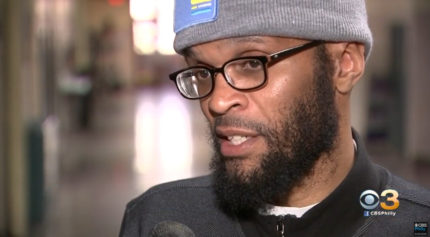Has Ad Reinhardt risen from the grave to vandalize the East Coast? Probably not. But officials don’t have a much better idea of who destroyed this culturally significant mural, which was an important milepost on the city’s tour route of black history-themed public art.
“We’re not exactly sure what happened at this moment,” says Thora Jacobson, director of design review at Philadelphia’s Mural Arts Program. “We have other mural artists working in the neighborhood and we’re asking them if they saw what happened. Our operations guy said it must have been done with a lift and a professional spray gun.”
Some critics say Philly has plenty of butt-ugly murals that would benefit from a total paint-over. This wasn’t one of them. Of the more than 3,000 indoor and outdoor murals that MAP has commissioned over the years, the Thrash artwork stood out for its artistic and educational merit.
Now you don’t.Dox Thrash was, at various points of his life, a janitor, elevator operator, hobo, Buffalo Soldier and bang-up creative force. Working out of the Philadelphia Fine Print Workshop, he produced poignant, velvety prints chronicling black life in the mid-20th century United States. When he was gifted with some of the deceased printmaker’s supplies, the curator of exhibits at Philadelphia’s African American Museum compared it to “getting a piece of the Holy Grail.”
The Thrash mural, located on the side of an abandoned house at 2442 Cecil B. Moore Avenue, depicted the artist working in his studio in a style mirroring his own beloved carborundum process. Eric Okdeh and Calvin Jones painted it in 2001 to coincide with a Thrash exhibition at the Philadelphia Museum of Art. Later, it became part of MAP’s public tour of 47 murals that “uniquely capture the rich African American experience in Philadelphia,” featuring a podcast narrated by none other than ?uestlove.
So why did it mysteriously disappear?
Staffers at MAP and a local outpost of the U.S. Department of Housing & Urban Development have established a spotty timeline. Sometime around May somebody defaced the mural with graffiti – which is darkly funny, given that MAP began in the ’80s as an anti-tagging initiative. Whoever owned the mortgage “decided the best thing to do was paint it over” during the summer, says Lisa Wolfe at HUD’s Office of Public Housing.
Read more: The Atlantic

